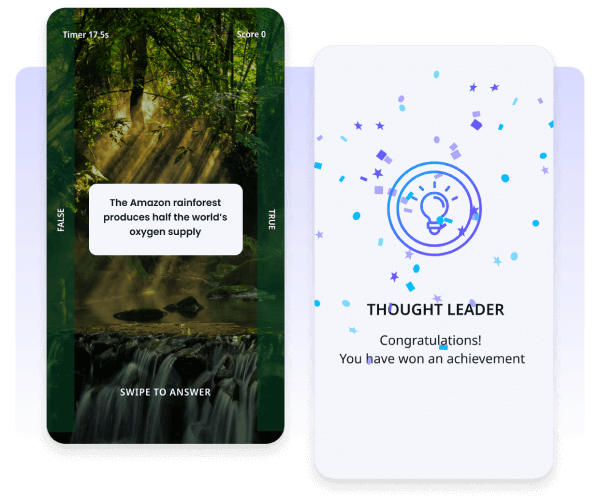
Gamified Wealth Goals: Leveling Up Your Finances as a Young Adult
For young adults, the world of personal finance can often seem overwhelming. From student loans to budgeting, saving for a down payment on a house, or investing for retirement, the responsibilities can pile up quickly. Traditional financial advice, while sound, can sometimes feel dry and uninspiring. Enter the world of gamification – a powerful tool that transforms the intimidating landscape of wealth-building into an engaging and rewarding game.
Why Gamification Works for Young Adults
Gamification involves applying game-design elements and game principles in non-game contexts. This can include point systems, leaderboards, challenges, rewards, and progress tracking. For young adults, who have grown up with video games and interactive technology, gamification offers a familiar and engaging approach to achieving financial goals.
Here’s why gamification is particularly effective for this demographic:
- Increased Engagement: Games are designed to be captivating. By incorporating game mechanics into financial planning, young adults are more likely to stay focused and motivated.
- Improved Understanding: Complex financial concepts can be broken down into smaller, more digestible challenges. This makes learning about personal finance less daunting and more accessible.
- Enhanced Motivation: The reward system inherent in games provides a sense of accomplishment and encourages continued progress. Positive reinforcement is a powerful motivator for building good financial habits.
- Reduced Anxiety: Financial planning can be stressful. Gamification introduces an element of fun and playfulness, which can help alleviate anxiety and make the process more enjoyable.
- Behavioral Change: Gamification can help young adults develop positive financial habits by rewarding desired behaviors and providing feedback on areas for improvement.
Key Elements of Gamified Wealth Goals
To effectively gamify wealth goals, consider incorporating these key elements:
- Clear Goals: Define specific, measurable, achievable, relevant, and time-bound (SMART) financial goals. For example, instead of "save more money," aim for "save $500 per month for a down payment on a house in two years."
- Points and Rewards: Assign points for completing financial tasks, such as creating a budget, paying off debt, or making an investment. Rewards can range from small treats (a coffee, a movie night) to larger incentives (a weekend getaway).
- Challenges: Introduce challenges to make the process more interesting. For example, a "no-spend week" challenge or a "side hustle" challenge to earn extra income.
- Progress Tracking: Use a spreadsheet, app, or visual tracker to monitor progress toward goals. Seeing progress can be incredibly motivating.
- Leaderboards (Optional): If you’re part of a group or community, consider creating a leaderboard to foster friendly competition.
- Levels and Badges: Break down larger goals into smaller levels and award badges for completing milestones. This provides a sense of accomplishment and encourages continued progress.
- Storytelling: Frame financial goals within a narrative or story. For example, "Become a Financial Superhero" or "Embark on a Journey to Financial Freedom."
- Feedback: Provide regular feedback on progress and identify areas for improvement. This helps young adults stay on track and make informed decisions.
Practical Examples of Gamified Wealth Goals
Here are some practical examples of how young adults can gamify their wealth goals:
-
Debt Payoff Quest:
- Goal: Pay off student loans or credit card debt.
- Points: Award points for each payment made, with bonus points for paying more than the minimum.
- Challenges: "Debt Snowball Challenge" (pay off smallest debt first) or "Debt Avalanche Challenge" (pay off highest-interest debt first).
- Rewards: Celebrate milestones with small rewards, such as a dinner out or a new gadget.
- Level Up: As debt is paid off, "level up" to higher stages of financial freedom.
-
Savings Challenge:
- Goal: Save a specific amount of money for a down payment, emergency fund, or vacation.
- Points: Award points for each deposit made into a savings account.
- Challenges: "52-Week Savings Challenge" (save a little more each week) or "Round-Up Challenge" (round up purchases and save the difference).
- Rewards: Use savings for a desired purchase or experience.
- Badges: Award badges for reaching savings milestones (e.g., "Emergency Fund Starter," "Down Payment Dreamer").
-
Investing Adventure:
- Goal: Start investing in the stock market or other assets.
- Points: Award points for researching investments, opening a brokerage account, and making initial investments.
- Challenges: "Diversification Challenge" (invest in different asset classes) or "Long-Term Investing Challenge" (hold investments for a specific period).
- Rewards: Track investment growth and celebrate portfolio milestones.
- Levels: Progress through different levels of investing expertise (e.g., "Beginner Investor," "Intermediate Investor," "Advanced Investor").
-
Budgeting Bonanza:
- Goal: Create and stick to a budget.
- Points: Award points for creating a budget, tracking expenses, and staying within budget.
- Challenges: "No-Spend Week Challenge" or "Cut-the-Cord Challenge" (reduce monthly expenses).
- Rewards: Use saved money for a fun activity or purchase.
- Badges: Award badges for mastering budgeting skills (e.g., "Budgeting Pro," "Expense Tracker Extraordinaire").
Tools and Resources for Gamified Wealth Goals
Several apps and websites can help young adults gamify their wealth goals:
- Personal Capital: A free app that tracks net worth, expenses, and investments.
- Mint: A budgeting app that provides insights into spending habits and helps create budgets.
- Qapital: An app that uses gamification to help users save and invest.
- YNAB (You Need a Budget): A budgeting app that emphasizes conscious spending and goal setting.
- Twine: An app that allows users to save and invest with friends or partners.
Potential Pitfalls to Avoid
While gamification can be a powerful tool, it’s important to avoid these potential pitfalls:
- Focusing Too Much on Rewards: The primary focus should be on building good financial habits, not just earning rewards.
- Ignoring Financial Fundamentals: Gamification should supplement, not replace, sound financial advice.
- Taking on Too Much Risk: Avoid making impulsive investment decisions based on game mechanics.
- Comparing Yourself to Others: Focus on your own progress and avoid getting caught up in competition.
- Burnout: Avoid setting unrealistic goals or overdoing the gamification process.
The Future of Gamified Wealth Goals
As technology continues to evolve, the future of gamified wealth goals looks promising. We can expect to see more sophisticated apps and platforms that incorporate artificial intelligence, virtual reality, and personalized financial advice. Gamification has the potential to revolutionize the way young adults approach personal finance, making it more engaging, accessible, and rewarding.
Conclusion
Gamified wealth goals offer a fun and effective way for young adults to take control of their financial futures. By incorporating game mechanics into financial planning, young adults can increase engagement, improve understanding, enhance motivation, reduce anxiety, and develop positive financial habits. With the right tools and strategies, young adults can level up their finances and achieve their wealth goals in a way that is both enjoyable and rewarding.



